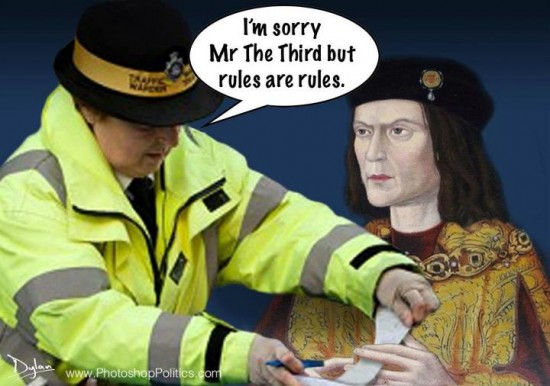
So, it appears that the long missing skeleton of King Richard III, the last Plantagenet king of England, has finally been found. And, in a creepy parallel to the case of Che Guevara, he was found in a rather ignominious location (in Richard’s case, a parking lot in Leicester; in Che’s, it was the airstrip at Vallegrande, Bolivia.) In a further creepy parallel, the skeleton was incomplete; the feet were missing, probably having been dug up by mistake in the Victorian era, when an outhouse was erected near the grave. (Compare to Che, whose hands were cut off just after his death, presumably for “identification”, but I suspect it really was more of a grisly trophy for his killers. They were some sick sons of mafiosi.) The skeleton’s pronounced spinal curvature indicates advanced scoliosis; Richard was inaccurately described by Shakespeare as hunchbacked. In fact, his body was twisted sideways in a C curve. This deformity was probably what led to the DNA testing that confirmed, via a distant Canadian descendant of Richard’s sister, that the skeleton was indeed that of the defeated, humiliated monarch.
And while the serious research into the facts of Richard’s brief reign (and his horrifying death) rages on, please enjoy a bit of levity, courtesy of the Onion. And the wag who photoshopped the picture above.




Think finding Richard III in a parking lot was odd, what about Martin Bormann, who supposedly escaped to South America and who the Germans spent years (and who knows how many Marks) tracking down, just to find he was buried out in front of Berlin Police headquarters?
Yep, that was a “facepalm” moment, for sure. On the other hand, Klaus Barbie and others were not such a joke…and there is apparently still a shred remaining of an “Aryan” colony in Paraguay that was supposedly frequented by Nazi war criminals, or at least one prominent one:
http://www.vice.com/the-vice-guide-to-travel/the-last-aryans-of-paraguay
http://en.wikipedia.org/wiki/Nueva_Germania
The experts used the Richard III skull to sculpt a lifelike reconstruction of his face. There are some interesting pictures of it online. It looks like the face of a reasonably good looking and pleasant young man. It is not gaunt and sinister looking like Richard’s portrait in many history books. This portrait may have been painted after he died and by that time he had a toxic reputation that could have been manufactured by the people who defeated him.
According to some accounts Richard tried to rally his troops by leading a cavalry charge at Henry VI. Richard is said to have killed at least one enemy soldier, unhorsed another who was a jousting champion, and got to within about four feet of Henry when Richard was killed. If this story is true Richard was fairly strong and vigorous for a very slender man with a pronounced spinal deformity.
Recent articles say the build of the skeleton is almost slender enough to be feminine. It is about 5 feet 8 inches long, which would have been tall in Richard’s day 500 years ago if he had been capable of standing up straight. He was about 32 years old when he died.
Yes, Richard III is a far more interesting figure than he’s generally made out to be. I read that he introduced some liberal reforms during his reign, such as bail for prisoners. That’s quite the change, considering that in those days, jail was usually a place where you rotted and perished. The excavation was also spearheaded by a group seeking to rehabilitate him in the public eye, since most of what we “know” (or used to) about him was actually Tudor propaganda that came in the wake of Henry Tudor’s accession to the throne.
Most interesting, though, is a little vignette I read in a Reader’s Digest book about a poor peasant, Robert Nixon, who apparently “saw” the battle of Bosworth Field as it was going down, even though he was nowhere near it. He had a reputation for shouting out odd and seemingly incoherent things, and was believed to be simple-minded. But on the day of Richard’s last battle, he was heard to cry out, while plowing a field: “Now Dick! Now Harry! Oh, ill done, Dick! Oh, well done, Harry! Harry has gained the day!” At the time, nobody knew what to make of it, other than that it made a bit more sense than most of Robert’s strange ramblings. The next day, news came of the battle, and people realized who “Dick” and “Harry” must have been. The ending of the story is sad, though: Henry sent for Robert, after hearing of this, and Robert of course knew about it even before the envoy left the palace. He was “thrown into a fit of great distress, running about the town of Over and crying out that Henry had sent for him and he would be clammed — starved to death!” Which he was, albeit inadvertently…Henry had to leave London on official business, and left Robert in the charge of one of his officers. The officer locked him into a palace closet to protect him from the rest of the domestics, who envied his privileges and no doubt had it in for him. But then the officer was also called away, and in his hurry he forgot to leave the key or instructions to release Robert and feed him. By the time he returned, Robert had indeed starved to death, just as he’d predicted.
Oops. Make that Henry VII.